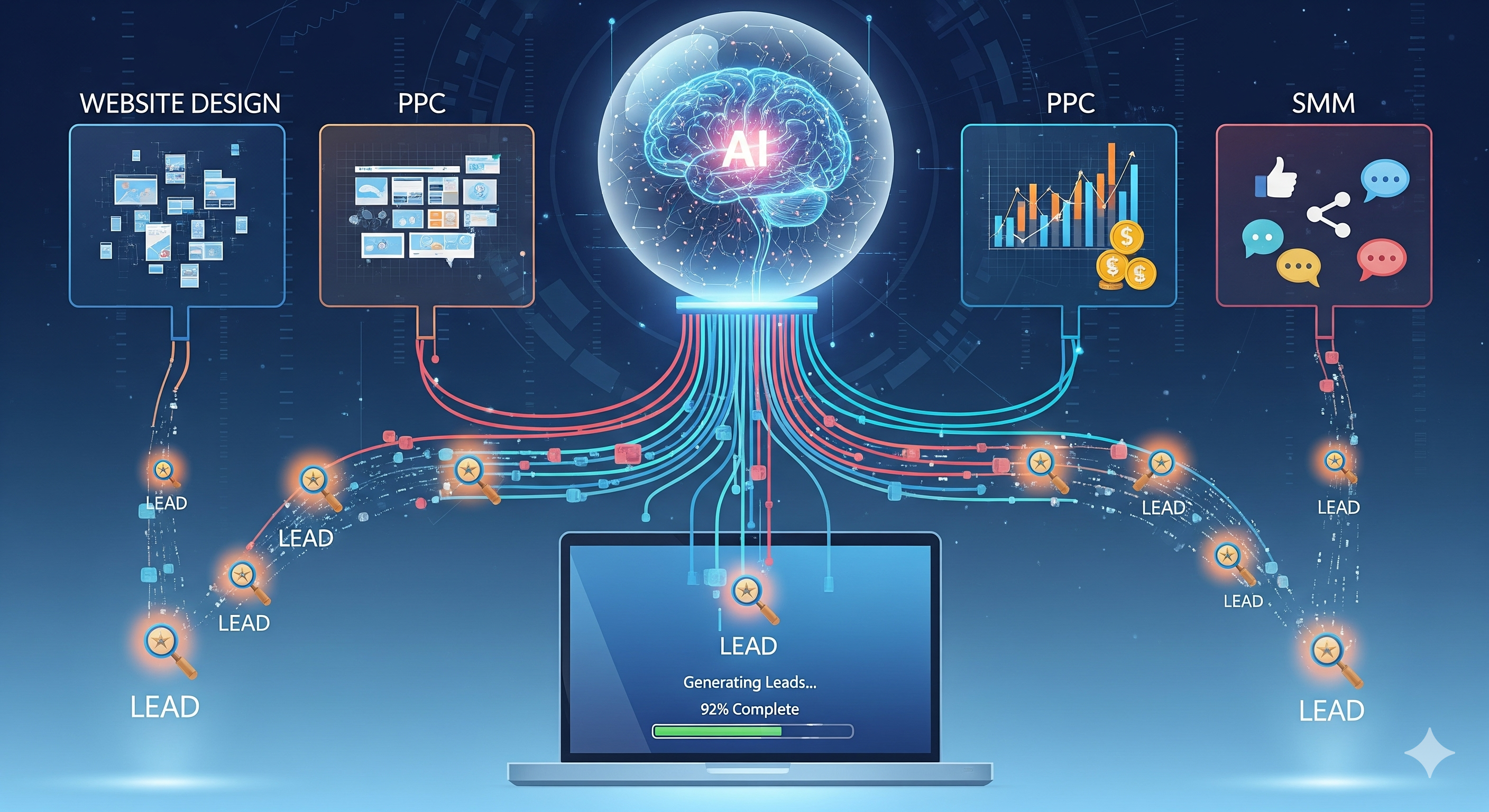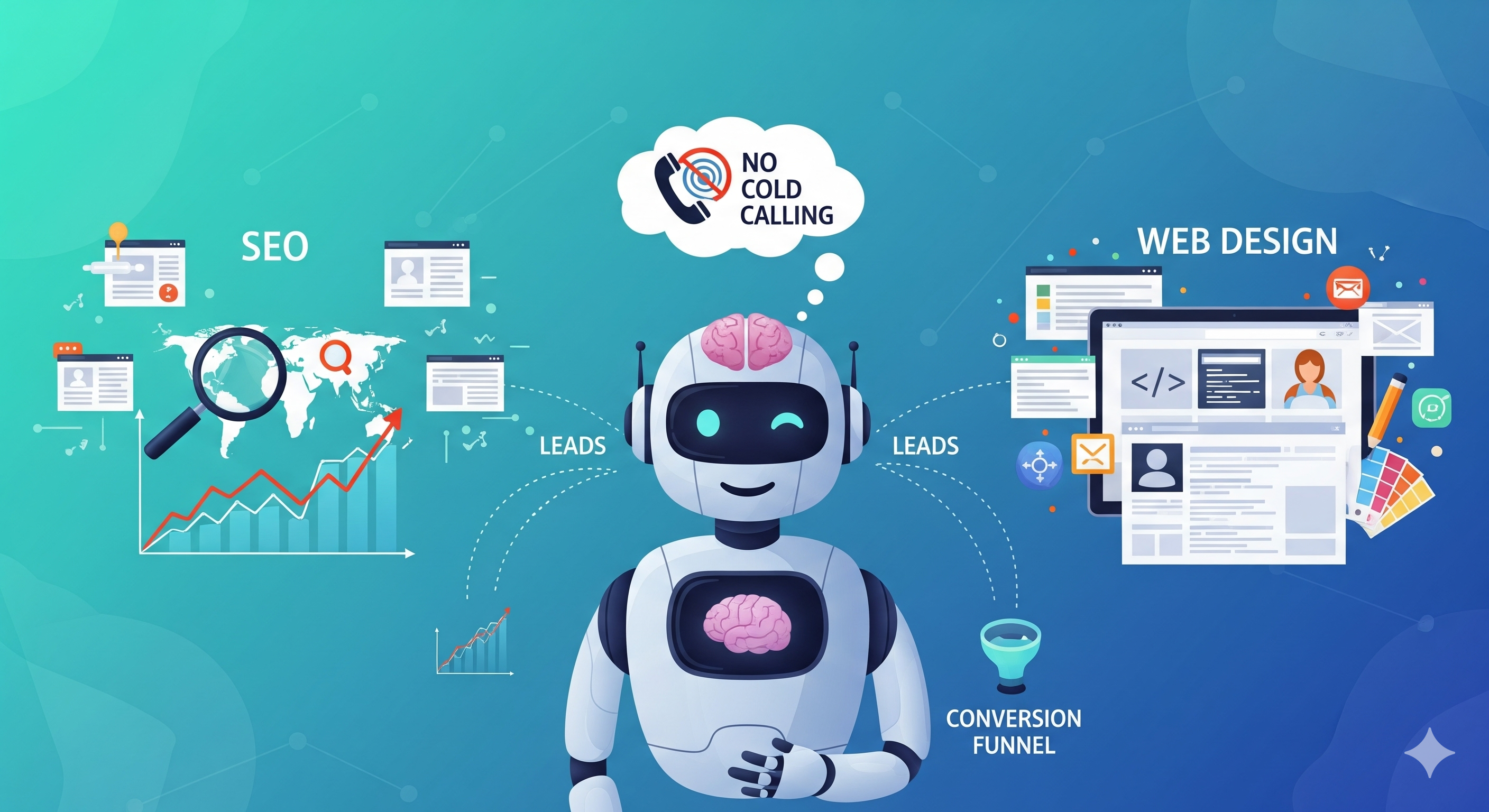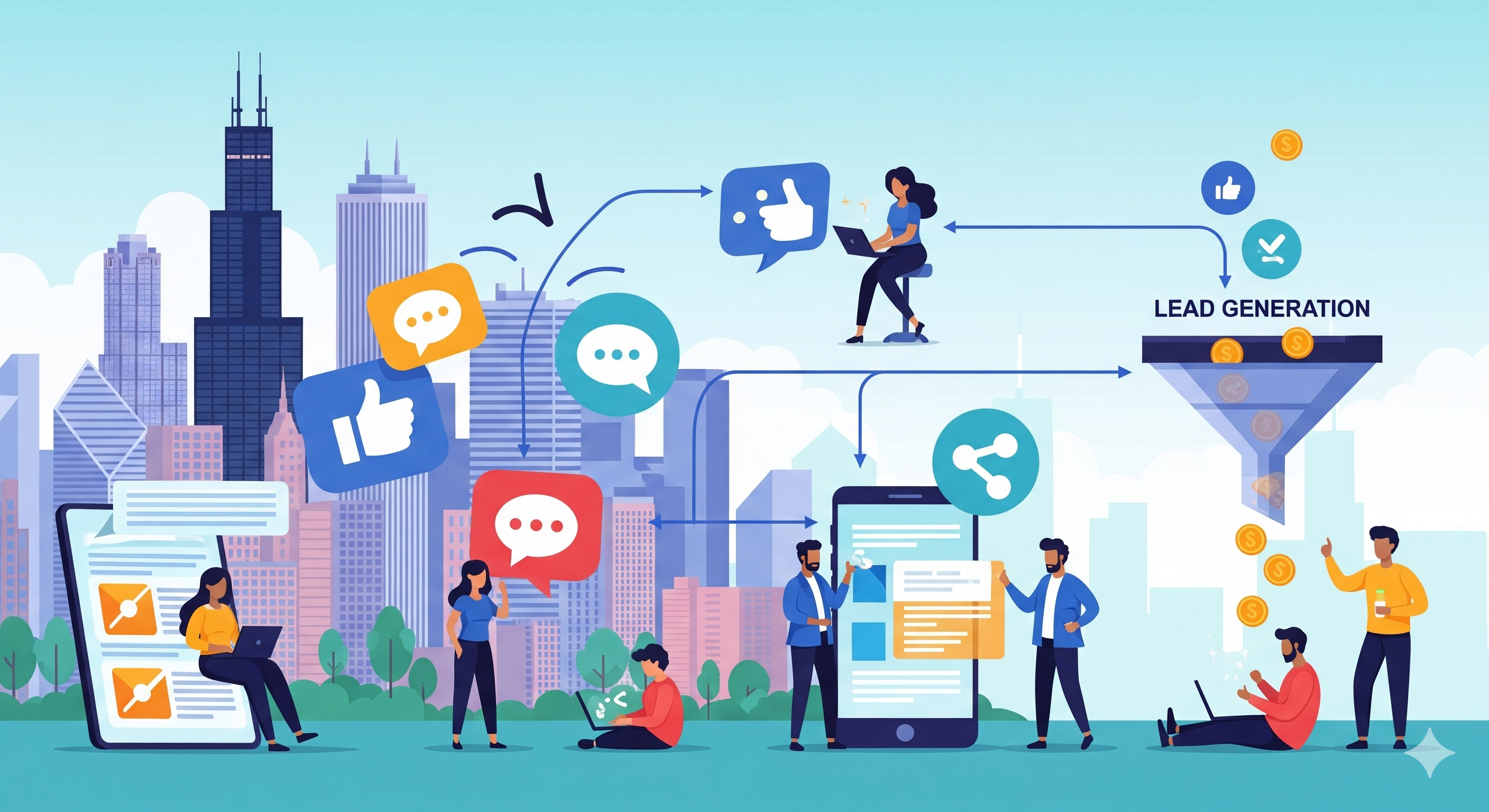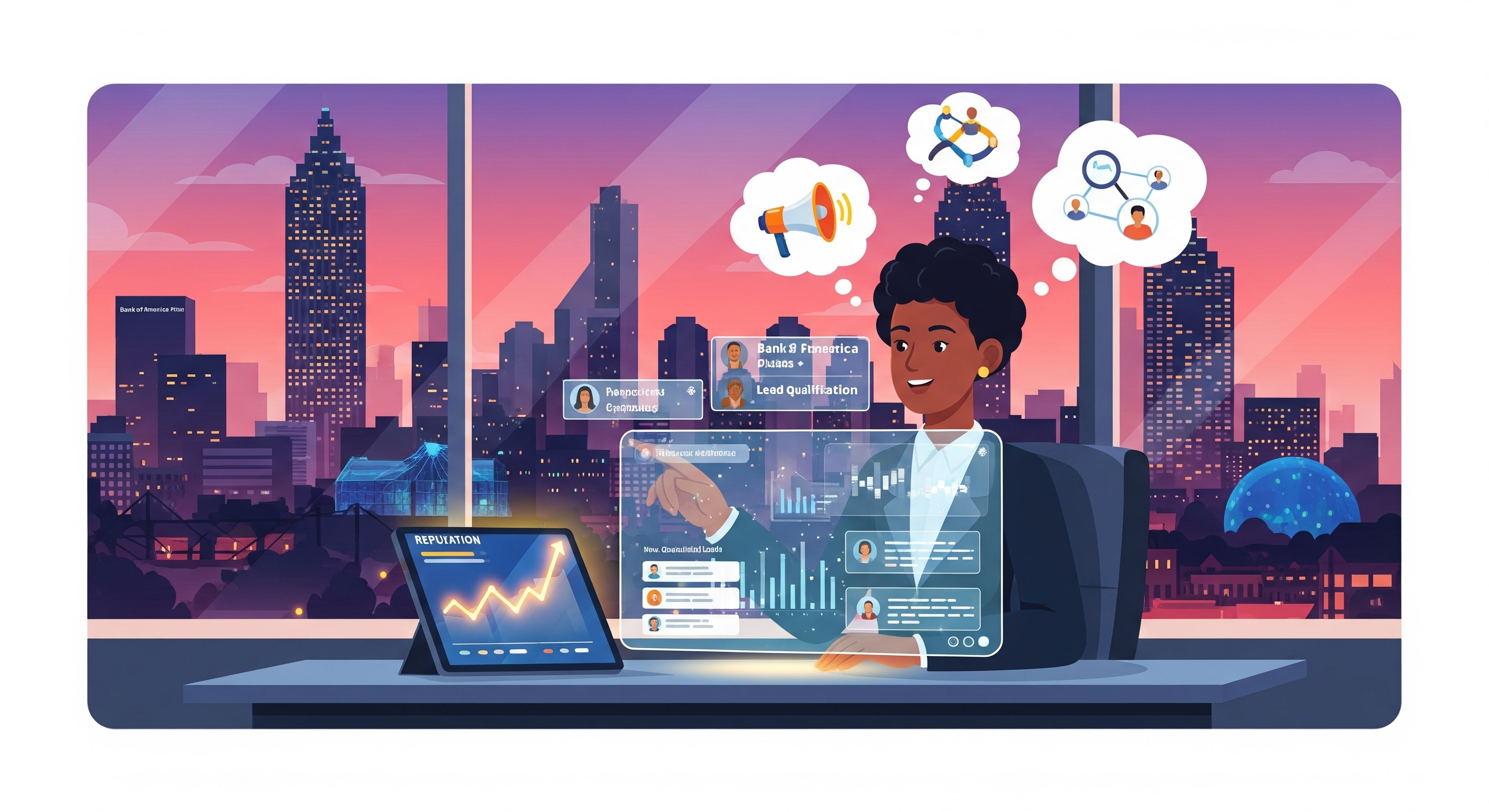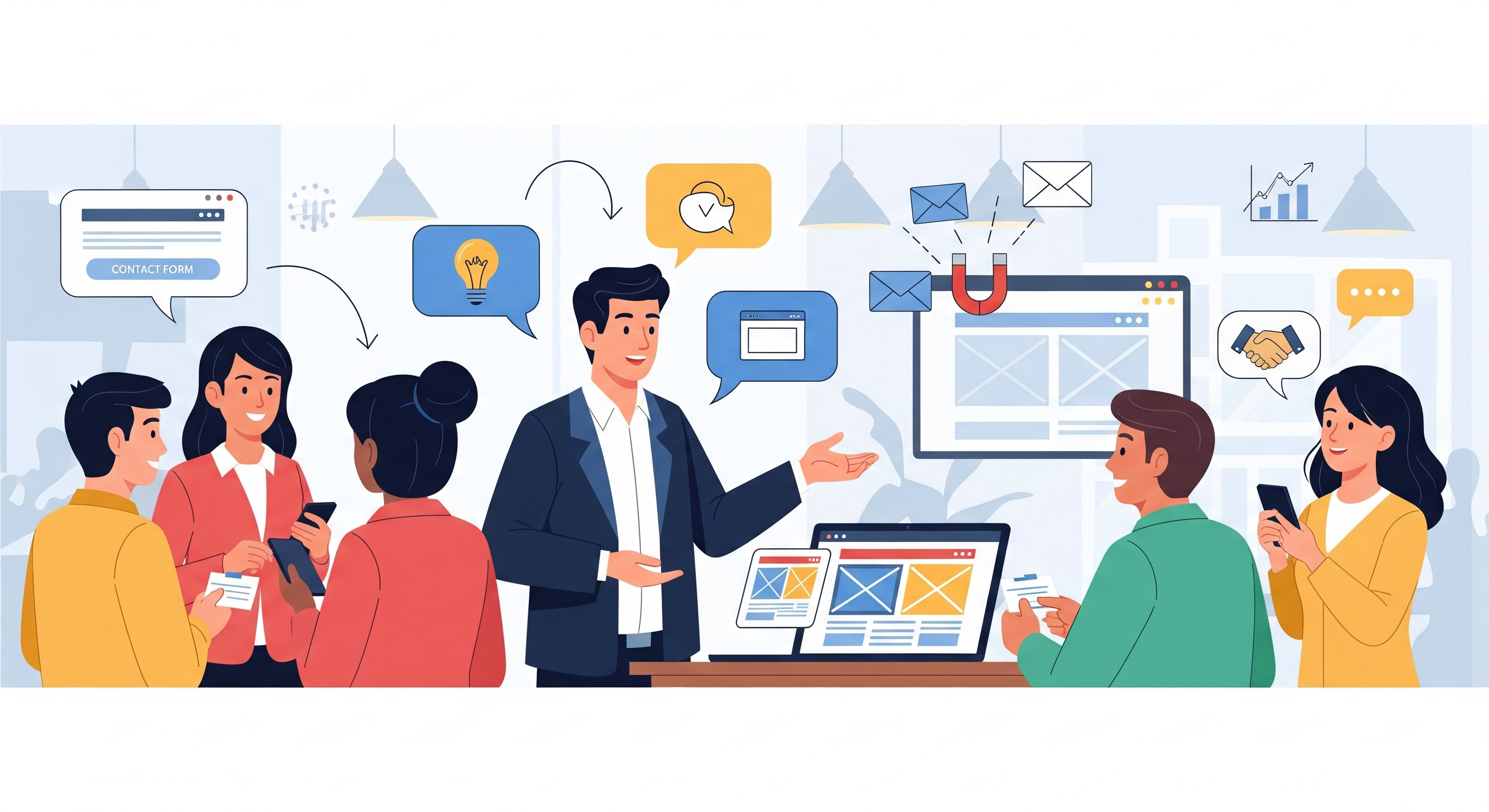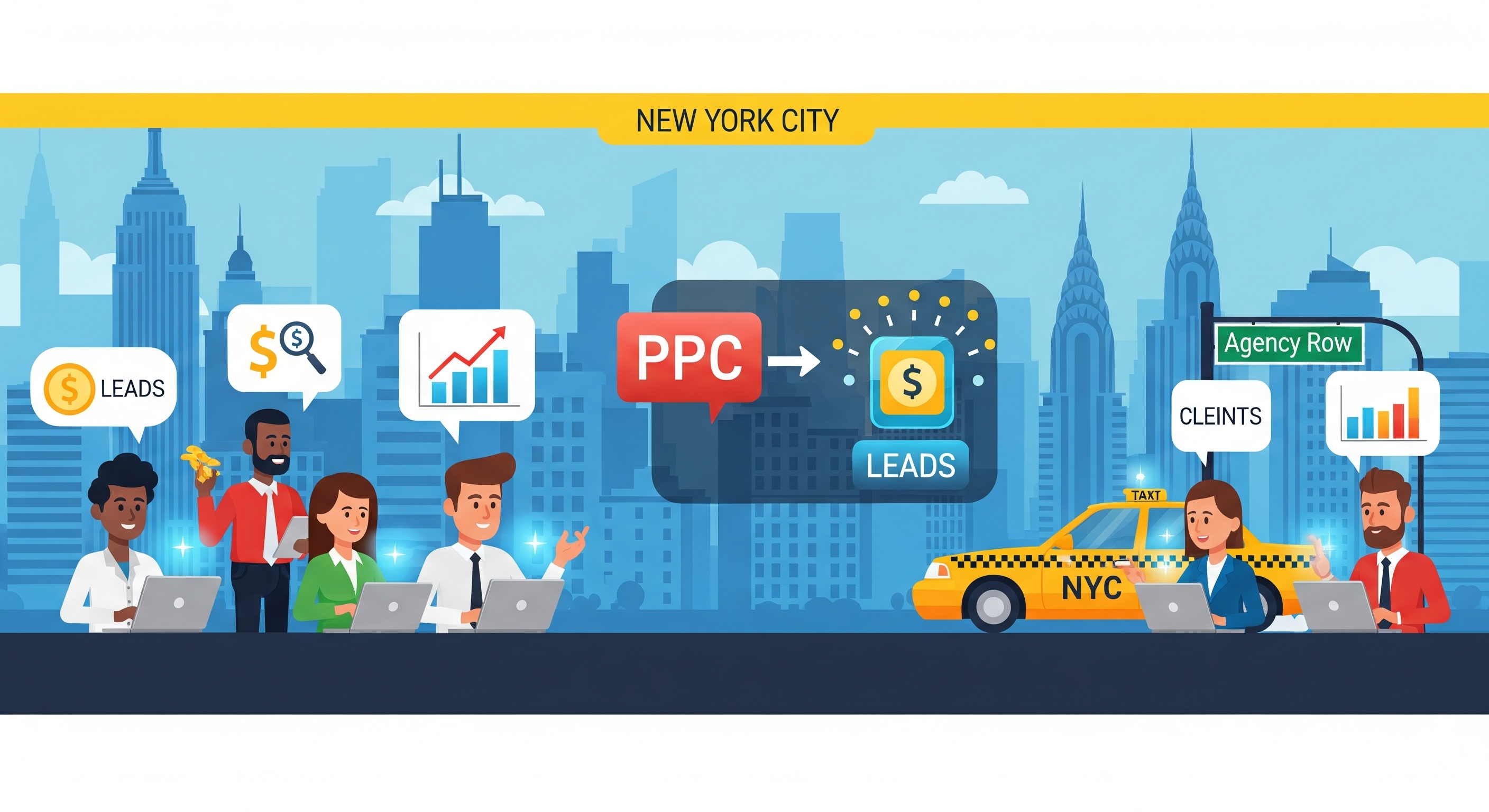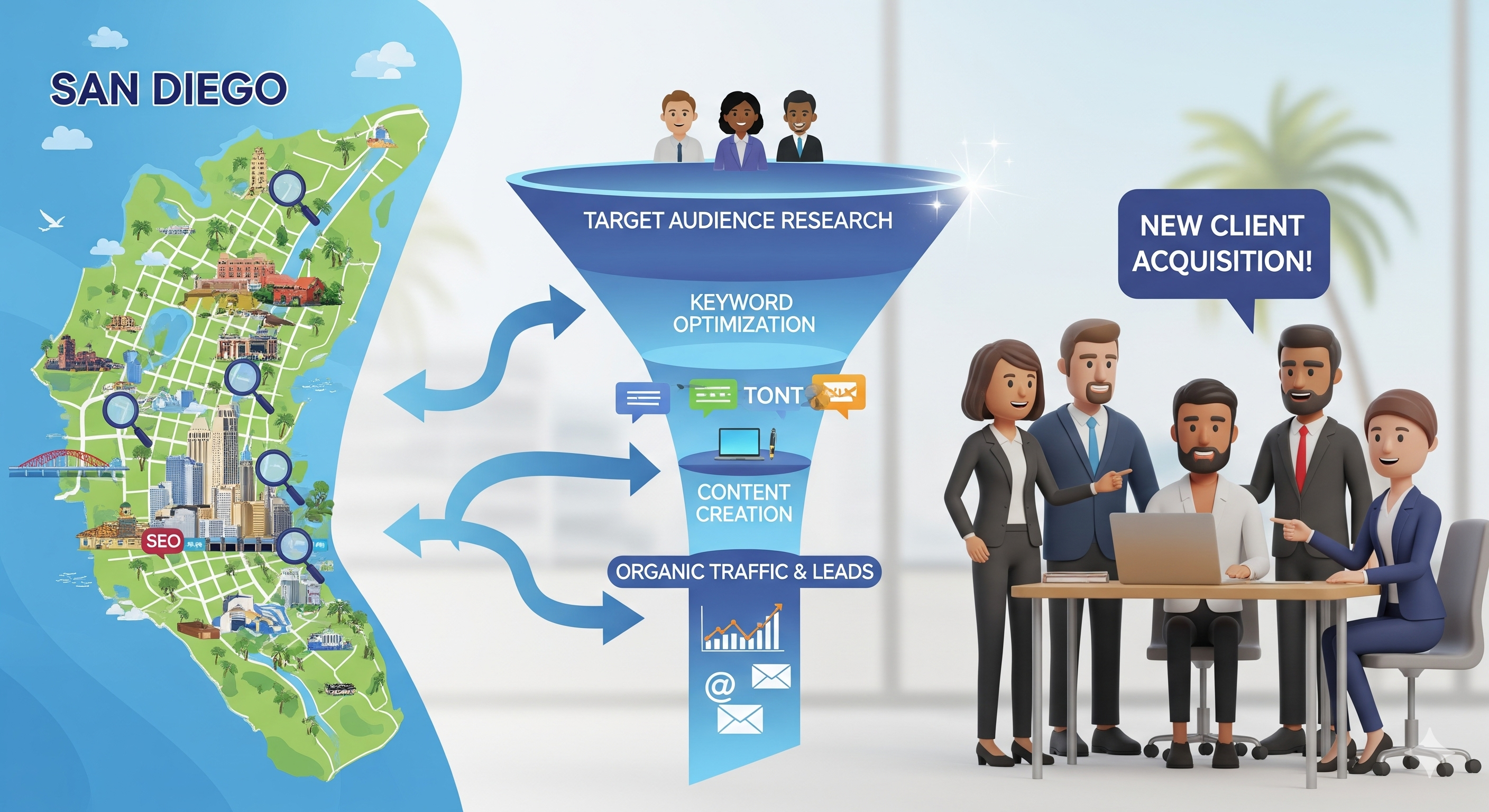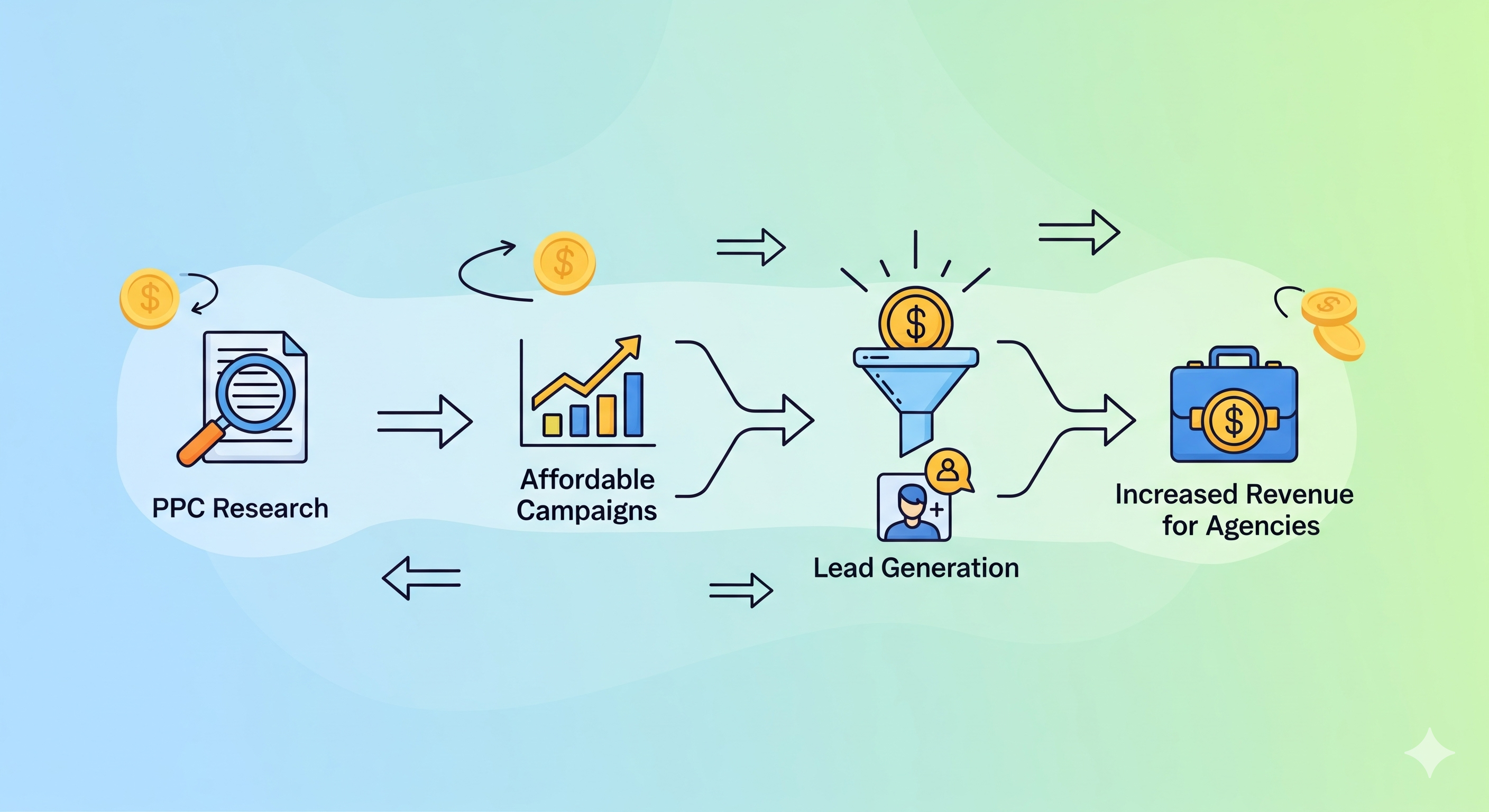In today’s fast-paced digital world, finding high-quality leads for your web design, PPC, and SMM services can be challenging. Traditional methods like cold calling or manually searching for prospects are time-consuming and often ineffective. This is where AI-powered lead generation comes in, revolutionizing how agencies find clients and grow their business. Why AI Leads Are a Game-Changer AI-driven lead generation uses intelligent algorithms to identify potential clients who are most likely to convert. By analyzing user behavior, business data, and online activity, AI can pinpoint the right contacts for your services, saving you hours of manual research. Key benefits include: Web Design Leads Finding clients for web design services can be tough, especially with so many agencies in the market. AI-powered tools analyze online presence, recent website activities, and business growth trends to generate leads that are ready to invest in a new website or redesign. Benefits of AI web design leads: PPC Leads Pay-per-click advertising requires clients who understand its value and have a marketing budget. AI lead systems filter businesses actively running or planning campaigns, giving your agency warm leads that are already interested in PPC services. Advantages include: SMM Leads Social media marketing success depends on connecting with businesses that want to engage their audience online. AI identifies companies with social presence gaps or recent social activity indicating potential interest in SMM services. AI SMM leads offer: Why Choose AI-Powered Leads from Website SEO Leads At WebsiteSeoLeads, we specialize in providing agencies with AI-optimized leads across web design, PPC, and SMM. Our system ensures you get: By using AI-powered leads, your agency can focus on what matters most – closing deals and delivering excellent services to clients. Conclusion If you’re tired of low-quality leads and endless cold calls, it’s time to upgrade to AI-powered web design, PPC, and SMM leads. With smarter targeting and higher conversion potential, your agency can grow faster and work more efficiently. Start getting AI-optimized leads today at WebsiteSeoLeads and watch your client base expand without the hassle of traditional lead generation.
AI Optimized SEO and Web Design Leads Without Cold Calling
Generating leads for SEO and web design services can be one of the most challenging parts of running a digital agency. Traditional methods like cold calling are often time-consuming, stressful, and yield low conversion rates. But what if you could leverage AI to find high-quality leads effortlessly? That’s where AI-optimized solutions come in. At WebsiteSeoLeads, we specialize in providing agencies with AI-driven SEO, web design, PPC, and SMM leads that eliminate the need for cold calling. Let’s explore how AI can transform your lead generation process. How AI Changes Lead Generation for SEO and Web Design Agencies AI technology can analyze massive amounts of data to identify businesses actively seeking digital services. This includes: By pinpointing these prospects, AI ensures your team focuses only on leads that are likely to convert, saving time and increasing ROI. Benefits of AI-Optimized Leads Types of Leads You Can Get At Website SEO Leads, we provide a variety of leads optimized with AI, including: Why Choose AI-Optimized Leads Over Cold Calling Cold calling can feel intrusive, and most prospects ignore unsolicited calls. AI-optimized leads, however, allow you to: How Website SEO Leads Helps You Grow Our platform provides agencies with ready-to-use, AI-optimized leads. Each lead includes: This ensures your outreach is not only effective but also highly targeted, increasing the chances of converting leads into loyal clients. Get Started Today If you’re tired of cold calling and want to grow your SEO or web design agency with high-quality leads, Website SEO Leads is your go-to solution. Our AI-powered system delivers the leads you need to focus on what matters most – providing exceptional services and growing your agency. Start getting AI-optimized leads today and transform your lead generation process.
Proven Social Media Marketing Lead Generation Company in Chicago
Chicago is a dynamic business hub with a thriving mix of startups, small businesses, and large enterprises. In today’s competitive marketplace, social media has become a critical tool for businesses to connect with customers, build brand awareness, and drive sales. While many companies understand the importance of social media, not all have the expertise or resources to manage campaigns effectively. This creates a prime opportunity for agencies that specialize in social media marketing. However, the challenge for Chicago agencies is finding the right clients—businesses that are actively looking for professional social media services. This is where WebsiteSeoLeads comes in as a proven social media marketing lead generation company, helping agencies in Chicago acquire high-quality, warm leads that are ready to convert. Why Social Media Marketing Leads Are Essential for Chicago Agencies Chicago’s business landscape is diverse, spanning retail, hospitality, professional services, technology, and more. Social media platforms such as Facebook, Instagram, LinkedIn, and TikTok are essential channels for these businesses to reach their target audiences. Yet, many businesses struggle to optimize these platforms for growth. For marketing agencies, the key to scaling operations and increasing revenue lies in securing clients who recognize the value of social media marketing. Cold outreach and general advertising campaigns are often time-consuming and inefficient. A targeted lead generation solution ensures agencies connect with businesses already seeking social media expertise, maximizing conversion potential. How WebsiteSeoLeads Supports Chicago Agencies WebsiteSeoLeads is a trusted partner for Chicago agencies, providing verified, ready-to-engage leads tailored to their service offerings. Their approach focuses on quality over quantity, ensuring agencies receive prospects that are genuinely interested in social media marketing. Key advantages include: Benefits of Partnering with WebsiteSeoLeads Maximizing Social Media Marketing Leads in Chicago To ensure success with leads from WebsiteSeoLeads, agencies should adopt an effective follow-up strategy: Why Chicago Agencies Trust WebsiteSeoLeads Agencies across Chicago rely on WebsiteSeoLeads because it consistently delivers high-quality, actionable leads. Testimonials emphasize the accuracy of lead data, the relevance of prospects, and the company’s ability to help agencies expand quickly. By partnering with WebsiteSeoLeads, Chicago agencies gain access to businesses seeking social media marketing expertise, allowing them to focus on delivering results rather than sourcing prospects. Conclusion For agencies in Chicago, securing high-quality social media marketing clients is crucial for growth and long-term success. WebsiteSeoLeads provides a proven solution by delivering warm, verified leads tailored to each agency’s service offerings. By leveraging WebsiteSeoLeads, Chicago agencies can save time, increase conversion rates, and scale their business efficiently. In a competitive market, having access to targeted social media marketing leads is a game-changer, allowing agencies to focus on what they do best: creating impactful campaigns that drive measurable results for clients. Partnering with a trusted lead generation company like WebsiteSeoLeads ensures Chicago agencies stay ahead of the competition, consistently attract new clients, and build a strong presence in the digital marketing landscape.
High-Quality Reputation Management Leads for Agencies in Atlanta
In today’s competitive business environment, online reputation can make or break a company. Atlanta, a thriving hub for businesses ranging from hospitality and retail to professional services and tech startups, is no exception. Companies in this city increasingly recognize that positive reviews, social media presence, and strong public perception are crucial to attracting and retaining customers. For marketing agencies offering reputation management services, the key challenge is finding businesses that truly need these services. Searching for clients manually or relying on cold outreach can be time-consuming, expensive, and often ineffective. That’s where WebsiteSeoLeads comes in. By providing high-quality, warm leads, WebsiteSeoLeads helps Atlanta agencies connect with businesses actively seeking reputation management support. Why Reputation Management Leads Are Essential for Atlanta Agencies Atlanta is a city with a vibrant business ecosystem. From restaurants and boutique stores to corporate offices, companies are aware that online feedback can significantly influence customer decisions. However, many of these businesses lack the resources or expertise to manage their digital reputation effectively. This creates a tremendous opportunity for marketing agencies. Instead of spending time trying to identify potential clients, agencies can work smarter by engaging with verified leads who are already interested in improving their online presence. Reputation management leads help agencies focus on converting businesses that value their services, which translates to higher success rates and increased revenue. How WebsiteSeoLeads Supports Atlanta Agencies WebsiteSeoLeads specializes in delivering verified, warm leads that match the specific needs of marketing agencies. Their process is designed to ensure that every lead is relevant, accurate, and ready for engagement. For agencies in Atlanta, this means fewer dead-end contacts and more productive client conversations. Key features of WebsiteSeoLeads’ service include: Benefits of Partnering with WebsiteSeoLeads Maximizing Reputation Management Leads in Atlanta Receiving leads is only the first step. To maximize results, Atlanta agencies should approach follow-ups strategically: Why Atlanta Agencies Trust WebsiteSeoLeads Atlanta agencies rely on WebsiteSeoLeads for consistent, high-quality reputation management leads. Testimonials highlight the platform’s professionalism, accuracy, and ability to deliver leads that convert. By partnering with WebsiteSeoLeads, agencies can focus on creating meaningful results for clients while maintaining a steady stream of new opportunities. Conclusion For Atlanta marketing agencies, reputation management is a vital service that can greatly impact local businesses’ success. Partnering with WebsiteSeoLeads ensures agencies receive high-quality, verified leads that are ready for engagement. In a competitive city like Atlanta, having access to warm, targeted leads provides a significant advantage. WebsiteSeoLeads empowers agencies to grow their client base, enhance their service offerings, and strengthen their market presence. With verified leads and a strategic approach, Atlanta agencies can confidently expand their reputation management services and achieve long-term success in the digital marketing industry.
Trusted Web Design Lead Generation Partner for Miami Agencies
Miami is one of the fastest-growing business hubs in the United States, filled with startups, retail brands, restaurants, and professional services all competing for attention. With such a dynamic business environment, the demand for high-quality websites has never been greater. Businesses understand that a professional, user-friendly website is essential for credibility, customer engagement, and long-term growth. For marketing and web design agencies in Miami, this creates enormous opportunities—but it also presents a major challenge: finding clients who are ready to invest in professional web design services. Cold calls and broad advertising campaigns can be expensive and unpredictable. That’s why many Miami agencies turn to WebsiteSeoLeads, a trusted web design lead generation partner that delivers warm, qualified leads to help agencies grow faster. Why Miami Agencies Need Web Design Lead Generation Miami’s diverse economy makes it a prime location for web design services. From hospitality and tourism businesses to tech startups and professional firms, every industry in the city needs an online presence to remain competitive. However, not every business owner knows where to find the right web design agency. This is where web design lead generation becomes crucial. Instead of relying on outdated strategies like cold outreach, agencies can connect directly with businesses that are already looking for web design solutions. For agencies in Miami, this means less time searching for clients and more time focusing on building websites that deliver results. How WebsiteSeoLeads Helps Miami Agencies WebsiteSeoLeads has built a reputation as a trusted partner for agencies seeking reliable web design leads. With over a decade of experience in digital marketing and lead generation, the company understands exactly what agencies need to succeed. Their process ensures that every lead provided is accurate, verified, and relevant to web design services. Here’s how WebsiteSeoLeads stands out: By partnering with WebsiteSeoLeads, Miami agencies can focus on what they do best—delivering cutting-edge web design solutions—while knowing that their lead pipeline is consistently filled. Benefits of Partnering with a Lead Generation Expert Best Practices for Miami Agencies Using Web Design Leads Getting high-quality leads is only the first step. To maximize results, agencies should follow these best practices: Why Miami Agencies Trust WebsiteSeoLeads Agencies in Miami choose WebsiteSeoLeads because of its proven track record of delivering reliable, high-converting leads. By focusing on accuracy, quality, and relevance, the company provides a service that directly impacts agency growth. In a city as competitive as Miami, where businesses are constantly seeking to upgrade their digital presence, having a steady supply of warm web design leads is a game-changer. WebsiteSeoLeads gives agencies the tools and support they need to focus on their craft while growing their client base consistently. Conclusion For web design agencies in Miami, success depends on finding clients who are ready to invest in building or improving their websites. WebsiteSeoLeads serves as a trusted partner, providing qualified, location-specific leads that allow agencies to grow efficiently and predictably. By combining industry expertise with a targeted approach, WebsiteSeoLeads ensures that Miami agencies receive leads that are both relevant and reliable. With their support, agencies can reduce time spent on client acquisition, improve conversion rates, and focus on delivering outstanding web design solutions. If your agency in Miami is looking to expand its client base, WebsiteSeoLeads is the partner you can trust to provide the high-quality web design leads you need to succeed in today’s competitive marketplace.
Exclusive PPC Lead Generation Services for Agencies in New York City
New York City is one of the most competitive business markets in the world. From small startups to Fortune 500 companies, businesses here are constantly investing in paid advertising campaigns to stand out and reach their audiences. Pay-Per-Click (PPC) advertising remains one of the most effective ways to generate visibility and immediate results. However, for agencies in New York City offering PPC services, the challenge lies not in delivering results—but in consistently finding businesses ready to invest in PPC campaigns. This is where WebsiteSeoLeads steps in. Known for providing warm, high-quality leads, WebsiteSeoLeads offers exclusive PPC lead generation services designed to help New York City agencies secure more clients without wasting time on cold outreach. Why PPC Leads Are Vital for NYC Agencies With so many businesses competing in New York City, companies understand that paid advertising is necessary to get noticed. Whether through Google Ads, Bing Ads, or social media advertising platforms, PPC ensures visibility at the top of search results or in highly targeted feeds. The demand for PPC is strong, but agencies face a common problem: connecting with business owners who are not just interested in PPC but are also ready to invest. Cold calling and generic outreach rarely deliver quality results in a city as fast-paced as New York. Agencies need access to businesses actively seeking PPC expertise. That’s exactly what WebsiteSeoLeads provides—verified, qualified leads that align with the services agencies offer. How WebsiteSeoLeads Supports New York Agencies WebsiteSeoLeads specializes in helping digital marketing agencies grow by providing exclusive, service-specific leads. For agencies in New York City focusing on PPC, their tailored lead generation services ensure that every lead represents a business with a genuine interest in running paid campaigns. Key features of their PPC lead generation services include: Benefits of Exclusive PPC Lead Generation How NYC Agencies Can Maximize PPC Leads Receiving high-quality leads is just the first step. To convert them into loyal clients, New York agencies should adopt a strong follow-up strategy: Why Agencies in New York Trust WebsiteSeoLeads WebsiteSeoLeads has built its reputation by delivering reliable, exclusive leads that help agencies grow faster. Their understanding of digital marketing and PPC ensures that the leads are not just names on a list, but businesses with real intent and interest. For agencies in New York City, this means less time wasted on cold calls and more time spent closing deals and running campaigns. With WebsiteSeoLeads, agencies can confidently scale their PPC services knowing they have a steady pipeline of qualified clients. Conclusion In a city as dynamic and competitive as New York, agencies need more than just great marketing skills—they need a consistent flow of new clients. Partnering with a trusted provider like WebsiteSeoLeads ensures that agencies gain access to exclusive PPC leads that are verified, targeted, and ready to convert. By focusing on delivering high-quality prospects, WebsiteSeoLeads empowers agencies to grow faster, close deals more effectively, and establish themselves as leading PPC providers in New York City. For agencies serious about scaling their business, WebsiteSeoLeads is the go-to partner for exclusive PPC lead generation.
Top SEO Lead Generation Company Helping Agencies in San Diego
San Diego is one of the fastest-growing business hubs in California, home to a diverse mix of industries, from tech startups and healthcare providers to restaurants and real estate firms. With so much competition, every business is looking for ways to improve its online visibility and attract more customers. This high demand for digital marketing services makes the city a great opportunity for agencies specializing in SEO. The challenge, however, lies in consistently finding new clients who are ready to invest in search engine optimization. For agencies, spending endless hours on cold calls or mass outreach can drain resources without guaranteeing results. That’s where a trusted partner like WebsiteSeoLeads comes in. As a top SEO lead generation company, WebsiteSeoLeads helps San Diego agencies connect with warm, qualified prospects who are actively looking for SEO services. Why SEO Leads Are Essential for San Diego Agencies SEO remains one of the most powerful tools for businesses to boost online visibility and attract long-term customers. In a competitive market like San Diego, ranking higher on Google can make a huge difference in traffic, credibility, and revenue. Local businesses—from law firms and medical clinics to e-commerce stores—know this, but many lack the in-house expertise to handle SEO effectively. This creates an opportunity for marketing agencies. The challenge isn’t convincing businesses that SEO is important; it’s finding those who are already interested and ready to invest. That’s where SEO lead generation makes all the difference. By receiving qualified leads, agencies can skip the guesswork and focus directly on prospects who understand the value of SEO. How WebsiteSeoLeads Supports San Diego Agencies WebsiteSeoLeads specializes in providing targeted, high-quality SEO leads tailored to agency needs. Instead of broad lists filled with uninterested contacts, they deliver leads that are verified, accurate, and genuinely interested in digital marketing solutions. Here’s how WebsiteSeoLeads helps agencies grow in San Diego: Benefits of Using SEO Lead Generation in San Diego How San Diego Agencies Can Maximize SEO Leads Getting quality leads is the first step, but converting them into loyal clients requires strategy. Here are some tips for San Diego agencies: Why San Diego Agencies Trust WebsiteSeoLeads Agencies in San Diego choose WebsiteSeoLeads because of the company’s consistent track record in delivering warm, high-converting leads. Their ability to filter prospects by industry and location ensures agencies don’t waste time on irrelevant contacts. With their help, agencies can build stronger pipelines, secure more contracts, and grow their businesses faster. For agencies aiming to establish themselves as top SEO providers in San Diego, having a steady flow of targeted leads is critical. WebsiteSeoLeads provides the foundation for consistent client acquisition, allowing agencies to focus on delivering impactful SEO campaigns instead of chasing down potential clients. Conclusion In a competitive city like San Diego, agencies need every advantage they can get. Partnering with a trusted SEO lead generation company like WebsiteSeoLeads ensures a consistent pipeline of warm, qualified prospects who are ready to invest in SEO services. By combining proven experience, accurate data, and a commitment to quality, WebsiteSeoLeads empowers agencies to grow with confidence. For San Diego agencies, this partnership means less time searching for clients and more time doing what they do best—helping local businesses succeed online. With WebsiteSeoLeads as a trusted partner, scaling your agency and increasing client acquisition has never been easier.
Trusted Social Media Marketing Lead Generation Company in Dallas
The digital landscape in Dallas is thriving, with businesses of all sizes competing to attract attention, build loyal audiences, and grow their brand online. Social media has become one of the most powerful tools for achieving these goals. For agencies offering social media marketing services, the challenge is not just about creating great campaigns—it’s also about finding new clients who need these services. That’s where WebsiteSeoLeads comes in. As a trusted social media marketing lead generation company, WebsiteSeoLeads helps Dallas agencies connect with businesses that are actively looking for social media expertise. By supplying warm, qualified leads, they make client acquisition easier, faster, and more cost-effective. Why Social Media Marketing Leads Matter for Dallas Agencies Dallas is home to a wide variety of industries—from hospitality and retail to tech startups and professional services. Each of these industries relies heavily on social media platforms like Facebook, Instagram, LinkedIn, and TikTok to reach customers. However, many businesses don’t have the in-house expertise to manage their social media strategies effectively. This creates a significant opportunity for marketing agencies in Dallas. The only problem? Finding the right businesses that are actively seeking help with social media. Cold calling or mass email campaigns rarely produce meaningful results. Instead, agencies need qualified leads—businesses that already understand the value of social media marketing and are ready to invest in professional services. WebsiteSeoLeads bridges this gap by providing agencies with accurate, verified leads that match their service offerings. How WebsiteSeoLeads Supports Dallas Agencies WebsiteSeoLeads specializes in generating warm, industry-specific leads that increase the likelihood of conversion. Their process focuses on quality rather than quantity, ensuring that Dallas agencies receive leads that are genuinely interested in social media marketing services. Here’s what sets WebsiteSeoLeads apart: Benefits of Partnering with WebsiteSeoLeads Maximizing Social Media Marketing Leads in Dallas To get the most value out of leads from WebsiteSeoLeads, Dallas agencies should approach outreach with a clear strategy. Here are some tips: Why Dallas Agencies Trust WebsiteSeoLeads Agencies in Dallas trust WebsiteSeoLeads because the company consistently delivers accurate, reliable, and high-converting leads. Their reputation is built on helping agencies grow faster without wasting time on cold prospects. For agencies that want to expand their social media client base, WebsiteSeoLeads provides the foundation for long-term success. Instead of worrying about where the next client will come from, agencies can focus on creating impactful campaigns that drive results for their clients. Conclusion In a competitive city like Dallas, agencies cannot afford to waste time on unqualified prospects. By partnering with a trusted social media marketing lead generation company like WebsiteSeoLeads, agencies gain access to warm, targeted leads that are ready to invest in their services. With proven expertise, a data-driven approach, and a strong commitment to quality, WebsiteSeoLeads empowers Dallas agencies to grow their client base and strengthen their presence in the digital marketing landscape. For agencies looking to maximize their opportunities in the fast-paced world of social media, WebsiteSeoLeads is the go-to partner for reliable and scalable lead generation.
Exclusive Web Design Leads for Fast-Growing Agencies in Miami
The web design industry in Miami is booming, fueled by a thriving business environment where companies are constantly seeking to build or improve their digital presence. From startups to established enterprises, every business understands that a strong, user-friendly website is essential for attracting customers and staying competitive. For web design agencies in Miami, this surge in demand creates enormous growth opportunities—but only if they can connect with the right clients. This is where WebsiteSeoLeads comes into the picture. As a trusted lead generation partner, WebsiteSeoLeads specializes in delivering exclusive, warm web design leads tailored for agencies looking to scale quickly. By providing high-quality prospects who are actively seeking web design services, WebsiteSeoLeads enables agencies to focus more on delivering outstanding results while spending less time chasing new business. Why Miami Agencies Need Exclusive Web Design Leads Miami’s dynamic market is home to thousands of businesses across industries such as hospitality, retail, healthcare, finance, and technology. Many of these businesses recognize the importance of having a professionally designed website but may not know where to begin. This opens the door for agencies to step in with solutions. However, the challenge lies in finding businesses that are ready to invest in professional web design. Traditional outreach methods like cold calling, generic ads, and networking often consume time and money without guaranteeing results. Exclusive leads from WebsiteSeoLeads eliminate this problem by connecting agencies directly with businesses that already have an expressed interest in web design services. What Makes WebsiteSeoLeads Different? Unlike other platforms that provide generic or shared leads, WebsiteSeoLeads focuses on exclusivity and quality. Each lead is carefully vetted to ensure that agencies receive genuine opportunities from businesses looking for professional web design. Here are a few key features that set WebsiteSeoLeads apart for Miami agencies: Benefits of Exclusive Web Design Leads For agencies in Miami, exclusive leads from WebsiteSeoLeads bring several advantages: How Miami Agencies Can Maximize Leads from WebsiteSeoLeads Getting exclusive leads is only the first step; converting them into long-term clients requires strategy. Here are a few tips for Miami web design agencies: Why Miami Agencies Trust WebsiteSeoLeads Agencies across Miami trust WebsiteSeoLeads because of its consistent results and client-focused approach. By eliminating the guesswork in client acquisition, WebsiteSeoLeads allows agencies to focus on delivering top-tier web design solutions while maintaining a reliable pipeline of new opportunities. Miami’s business landscape is competitive, and agencies that wait for referrals or rely on generic ads risk falling behind. WebsiteSeoLeads provides the competitive edge by ensuring agencies always have access to businesses that are actively searching for web design services. Conclusion For fast-growing web design agencies in Miami, success depends on having a consistent flow of qualified clients. WebsiteSeoLeads makes this possible by offering exclusive, verified web design leads that take the uncertainty out of client acquisition. With the right leads in hand, agencies can focus on their strengths—building stunning, high-performing websites—while WebsiteSeoLeads ensures the pipeline never runs dry. In a thriving city like Miami, where businesses are constantly competing for attention, partnering with a reliable lead generation company is not just an option—it’s a necessity. WebsiteSeoLeads provides the tools and expertise Miami agencies need to grow faster, close more deals, and establish themselves as leaders in the web design industry.
Affordable PPC Lead Generation Solutions for Agencies in Chicago
In the ever-changing world of digital marketing, agencies in Chicago are under constant pressure to deliver results for their clients while simultaneously growing their own business. Pay-Per-Click (PPC) advertising remains one of the most effective ways to drive immediate visibility and measurable returns for businesses. But for agencies, the challenge is not only running successful PPC campaigns—it’s also about finding new clients who are ready to invest in paid advertising. This is where partnering with an experienced PPC lead generation company becomes a game-changer. Websiteseoleads.com has established itself as a trusted source for affordable PPC lead generation solutions, helping Chicago agencies connect with qualified prospects who are actively searching for digital marketing partners. By streamlining the client acquisition process, agencies can focus more on delivering impactful PPC campaigns and less on struggling to find their next client. Why PPC Lead Generation Matters for Chicago Agencies Chicago is home to thousands of businesses across industries—from local restaurants and retail shops to large corporations and startups. Many of these businesses recognize the value of PPC advertising for instant results but lack the expertise to manage it effectively. This creates a strong opportunity for agencies to step in. However, relying solely on traditional outreach methods like cold calls, email blasts, or generic ads often results in wasted time and resources. A dedicated PPC lead generation service helps Chicago agencies target businesses that are already interested in paid advertising solutions, making conversations more meaningful and conversions more likely. How Websiteseoleads Delivers Affordable PPC Leads What makes WebsiteSeoLeads stand out is their ability to provide warm, highly relevant leads at an affordable price point. Unlike mass lead lists that often include outdated or irrelevant information, their leads are verified, accurate, and tailored to agencies’ needs. Their process involves advanced research, analytics, and data-driven targeting to identify businesses that actively need PPC management. Whether it’s small businesses looking to expand locally or mid-sized companies aiming for aggressive growth, WebsiteSeoLeads ensures that Chicago agencies get access to the right prospects. This affordability factor allows even smaller agencies to compete effectively. Instead of spending large budgets on broad advertising campaigns, agencies can invest in cost-effective leads that have a much higher chance of conversion. Key Benefits of Using PPC Lead Generation Services How Chicago Agencies Can Maximize PPC Leads Getting access to high-quality leads is only the first step. The way agencies manage and nurture these leads determines overall success. Here are a few proven strategies: Why Chicago Agencies Trust Websiteseoleads.com Chicago’s competitive digital landscape requires agencies to stay ahead of the curve. Websiteseoleads.com has become a go-to partner for agencies seeking affordable PPC lead generation solutions because of their proven track record, industry experience, and commitment to quality. Agencies benefit from consistent access to businesses in need of PPC services without the uncertainty of cold outreach. By reducing acquisition costs and increasing efficiency, Chicago agencies can expand their client base, strengthen their reputation, and scale their operations with confidence. Conclusion For agencies in Chicago, success in digital marketing is not only about delivering strong PPC campaigns but also about building a consistent client pipeline. Websiteseoleads.com makes this possible by providing affordable, warm, and highly relevant PPC leads that save time, reduce costs, and maximize conversion potential. In a city filled with businesses eager to grow online, having a trusted lead generation partner can make the difference between struggling to find clients and thriving in a competitive market. With WebsiteSeoLeads, Chicago agencies can focus on what they do best—creating powerful PPC campaigns—while leaving the lead generation process to the experts.

